Menu
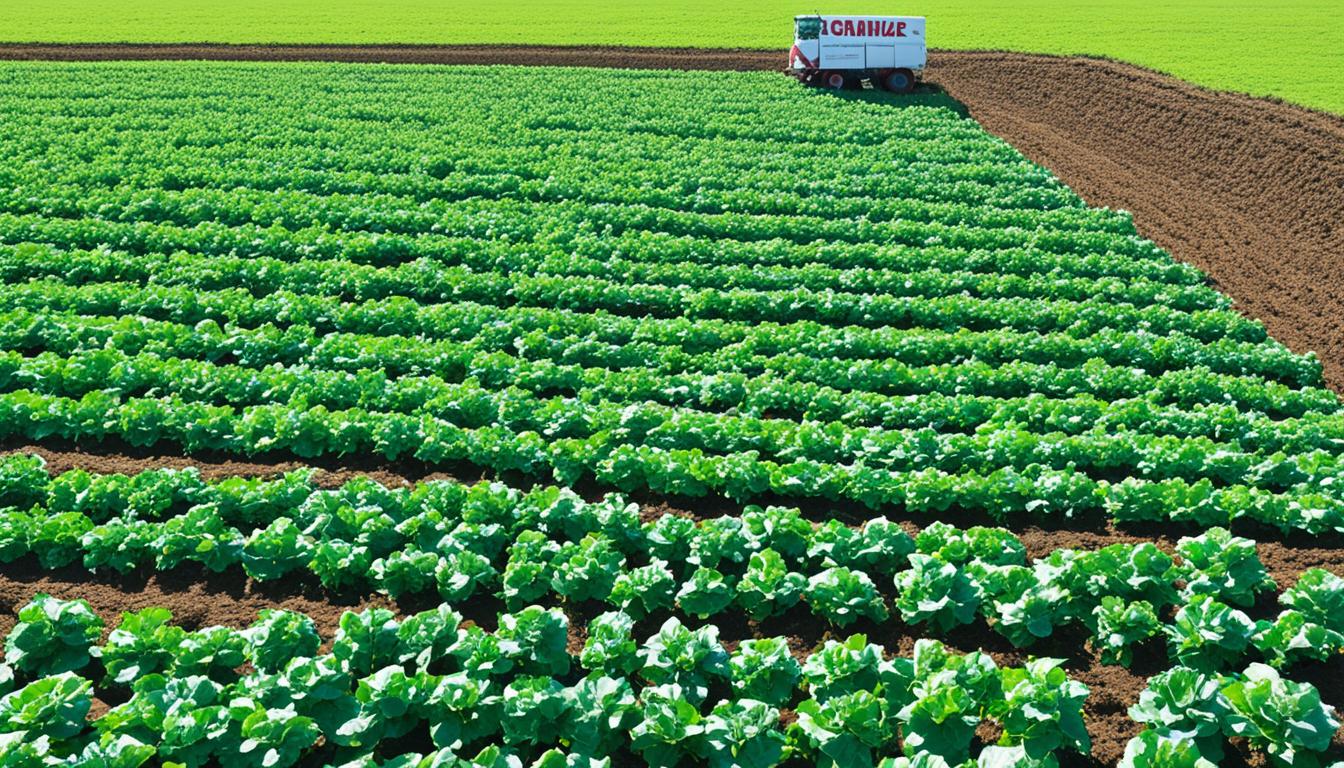
Have you thought about how a farm safety plan might keep your farm and its workers safe? When we look into farm safety, we see it’s more than following rules. It’s about making a place where everyone is healthy, happy, and works well.
Farms have many dangers, such as machines breaking, chemicals, and bad weather. I make sure to have a strong safety plan on my farm. This helps keep our team safe and looks after our animals, plants, and the environment. A good plan follows safety rules and makes farming safer and more effective.
In places like Minnesota, preparing for emergencies like tornadoes or fires is a must. We also need detailed maps showing the farm’s layout and what’s in each place. This includes where the animals are, any dangerous items, and how to turn off utilities. These plans are essential for stopping accidents and keeping the farm safe.
Keeping your farm safe is not just following rules. It’s about building a strong and safe place to work. Are you ready to make your farm’s safety plan the best it can be?
Farming is tough and filled with dangers. It’s important to keep safety in mind to protect everyone, including people living nearby. The use of heavy machinery, particularly tractors, can be very risky. Sadly, in 2018, there were 146 deaths in the U.S. because of tractor accidents.
Using chemicals on the farm, like pesticides, is another danger. These chemicals can harm people and the environment. Then there’s the risk from working with livestock. Caring for them or moving them can cause injuries. Plus, they can spread diseases such as Rabies.
Weather is also a big factor. Changes due to things like climate change bring extreme conditions. This can harm what’s grown and the animals. It also increases the chance of fires. Coping with these risks requires serious safety management in agriculture.
To make farms safer, using Personal Protective Equipment (PPE) is key. Everyone on the farm should know how to use machinery safely and handle chemicals right. They should also understand how to work with animals and avoid risks.
Farms need to regularly check for risks. Each farm is different, so it’s important to spot and deal with the specific dangers on every farm. Doing so helps keep everyone safe.
Health and safety agencies around the world, like OSHA in the U.S., put rules in place to protect farm workers. They encourage safe practices. New technologies, such as gadgets that connect to the internet and safer machinery, are also helping to make farms safer. They reduce the chances of accidents and protect workers better.
It’s key to know about hazards to stay safe on farms. A shocking fact from 2018 says 23.4 farm workers in the US died for every 100,000. This shows why farm safety is crucial.
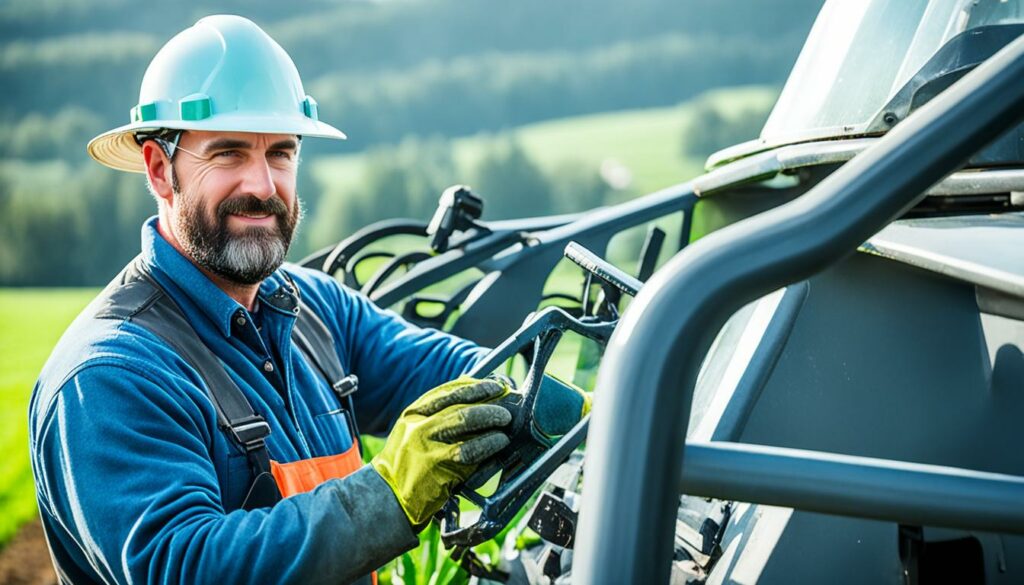
Around 2 million young people face farm dangers in the US each year. They are at a high risk in farming. For example, Australia says farming is more dangerous than any other job, causing 79 farmer deaths a year. Many get severely hurt by machines and vehicles.
There are specific dangers we need to look at, including:
Dealing with these risks through safety programmes is essential. It helps keep workers safe and makes the farm run better.
| Country | Hazard | Statistic |
|---|---|---|
| United States | Farm Worker Fatalities | 23.4 deaths per 100,000 workers (2018) |
| United States | Youth Exposure to Farm Hazards | 2 million annually |
| Australia | Agriculture Fatality Rate | Eight times higher than other industries (2021) |
| Australia | Farmer Deaths Annually | 79 on average |
In farming, safety management is key to keep both the farm and its people safe. It uses agricultural safety protocols to protect the workers, the animals, and crops. This ensures everyone stays well and the work can go on.
Every day, farm workers deal with big machines and dangerous chemicals. So, having strong safety rules is a must. In 2018, 146 people died because of tractor accidents in the U.S. This shows just how important safety is in farming.
Safety management also stops diseases passing between animals and people. This includes diseases like Rabies and Bovine Tuberculosis. It’s crucial to always check for risks and use strict agricultural safety protocols to keep everyone safe.
Bad weather, made worse by climate change, can hurt farms badly. Droughts, typhoons, and fires can ruin crops and hurt animals. So, safety plans must deal with these new risks to protect farming.
Using the right gear, like long shirts and gloves, is very important on farms. OSHA, the USDA in the U.S., and Safe Work Australia support this. They make sure farms follow safety rules to protect workers.
New technology like IoT, sensors, and drones can make safety checks better and faster. This helps find risks quickly and react fast. It makes farms safer for everyone.
Good safety management makes farms safer and stops many accidents. Putting safety first makes farming a better, more caring place. It values the lives and health of those who work there and the wider community.
Using Personal Protective Equipment (PPE) on farms is key for worker safety. It’s vital to pick the right PPE, use it correctly, and keep it in good shape. This helps decrease risks and makes farms safer places to work.
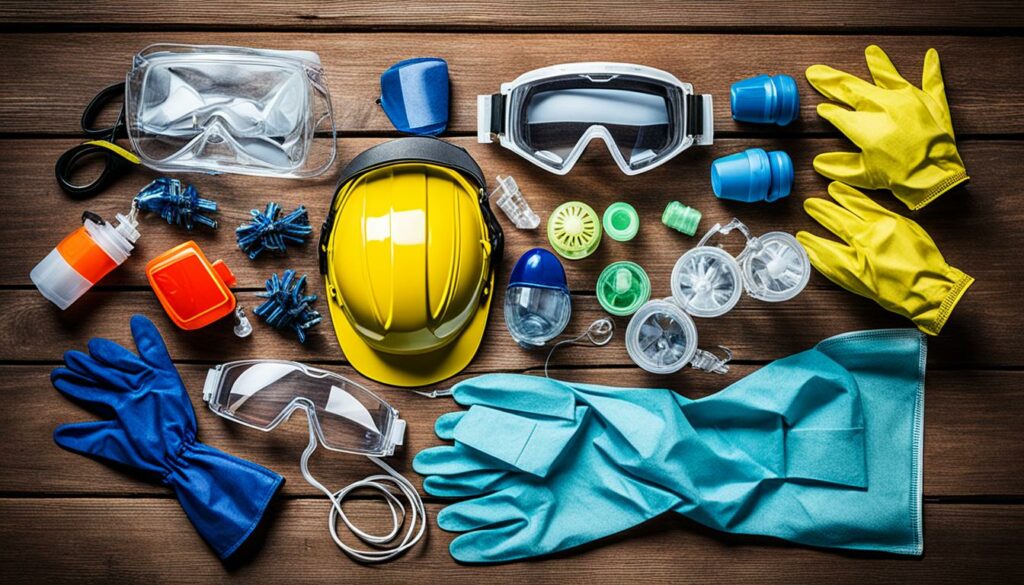
Choosing the right PPE means looking at the dangers on the farm. OSHA says workers need eye and face protection if they face things like flying bits, chemicals, or bright light.For jobs with dust or chemicals, like handling grain or spraying pesticides, you must protect your lungs. This could be a two-strap mask or a PAPR. And don’t forget about your ears. Earmuffs or earplugs stop loud machines from causing hearing loss.
It’s not enough to just have PPE. Workers need to know how to use it right. They should be taught how to wear and adjust it properly.Knowing how loud noises are and for how long you hear them helps choose the right hearing protection. PPE that fits well works best. Employers need to check if workers use PPE right and fix any mistakes they find.
It’s important to keep PPE in good condition. Filters in respirators need changing often. If something breaks or wears out, you need to get a new one fast.Farms should have regular checks to make sure all PPE is in top shape. And as technology changes, so does the PPE. It must always meet the newest safety standards.
| Type of PPE | Primary Use | Maintenance |
|---|---|---|
| Eye and Face Protection | Protection from flying particles and chemicals | Inspect for cracks, replace if damaged |
| Respiratory Protection | Protects from dust, gases, and chemicals | Change filters regularly |
| Hearing Protection | Prevents hearing loss from excessive noise | Replace earplugs regularly, check earmuff seals |
| Foot Protection | Protection from falling objects and puncture wounds | Inspect for wear and tear, replace if necessary |
| Head Protection | Provides protection from impact and falling objects | Inspect shell and suspension system, replace if damaged |
Farm safety training is vital to lower the many risks in farming. It covers using equipment safely, handling chemicals, and taking care of animals. This training gives workers the skills they need to be safe on the farm.
Knowing how to use farm machinery safely is very important. In 2018, 146 people died from farm machinery accidents in the U.S. Learning about tractor and power tool usage is key.
This training highlights the importance of features like Rollover Protective Structures (ROPS). ROPS can reduce risks from tractor rollovers and other accidents. In Minnesota, a special program helps farmers afford these safety devices by paying back part of their cost.
Understanding chemical risks is crucial in farming. Pesticides and fertilisers can harm people if not handled correctly. There are strict rules about how to store and use these chemicals from places like Safe Work Australia and EU-OSHA.
Teaching farmers about these rules improves chemical safety on farms. It’s a big step in keeping everyone safe from harm.
It’s important to know how to handle animals safely to avoid injuries. Livestock can act unpredictably. Workers need to learn how to manage and work with animals in a safe way.
Programmes hosted by the Progressive Agriculture Foundation are key in spreading safe livestock handling methods. Also, organizations like UMASH provide help to reduce injuries, including those from needles used with livestock.
Here’s a table that summarises important parts of farm safety training:
| Training Aspect | Key Focus Areas | Associated Programmes |
|---|---|---|
| Equipment Safety | Proper use of machinery, ROPS features, operator safety | ROPS Rebate Program, University of Minnesota Extension |
| Chemical Safety | Handling and storage of pesticides and fertilisers | Safe Work Australia, EU-OSHA |
| Livestock Safety | Safe handling techniques, injury prevention | Progressive Agriculture Safety Day, UMASH |
By teaching these key areas in farm safety training, we make agriculture safer. This means fewer dangerous accidents for farm workers.
It is vital to do farm risk assessments often. This helps keep farms safe and legal. By looking at possible dangers, farms can protect their workers, animals, and crops. This work makes farms not only safer but also more productive and happier places to work.
Finding possible dangers is key in farm risk assessments. Shockingly, 66.7% of farms had not assessed hazards for worker safety with animals, and 75% did not have a written safety plan. Farm work areas that need a close look include:
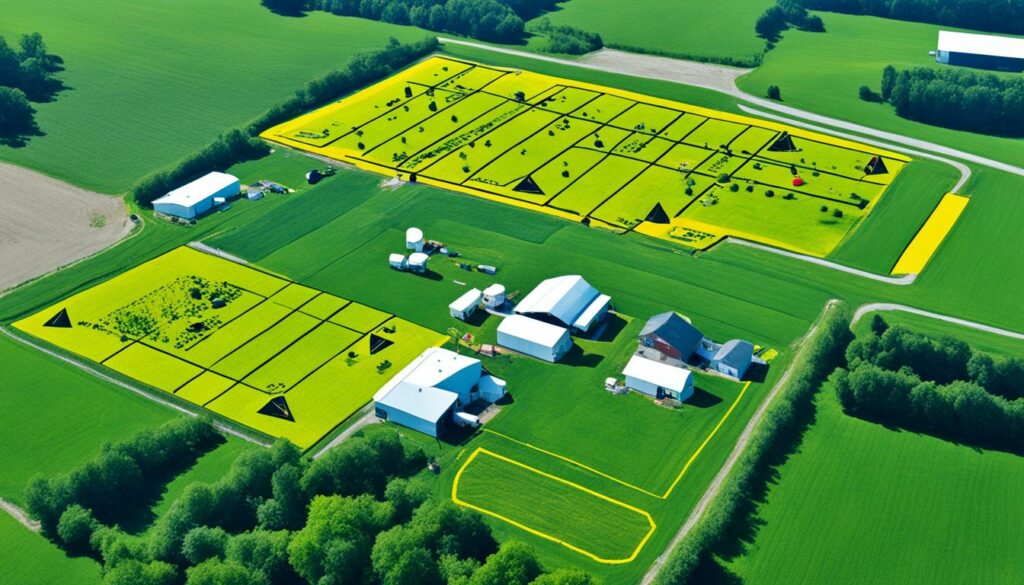
Properly finding hazards can cut risks and avoid accidents. For instance, over half of farm deaths come from tractor accidents. This highlights the importance of strict safety rules for using farm machinery.
After spotting hazards, creating special plans to reduce them is crucial. Sadly, 68.9% of farms were not consistent in managing hazards. Good strategies might involve:
Having a strong risk plan in farming means checking often and acting first. Unluckily, 55.2% of farms did not check safety routinely. This can lead to missing dangers. Planning regular checks helps build a safe culture and tackles risks as they arise.
Farm risk assessments do more than just tick boxes. They protect everyone in farming. With hazard spotting and risk plans, farms can cut accidents and make their work safer and more resilient.
Creating a good farm safety plan is key for everyone’s well-being. It requires knowing all the dangers like working with animals and machinery. With a solid safety plan, farms can be safer places to work.
A safety plan includes identifying risks like working with chemicals or dealing with livestock. It also means being ready for emergencies, setting safety rules, and helping employees know how to stay safe at work.
For a safety plan to work, leaders and everyone on the farm must work together. Shockingly, only a few Canadian farmers have a safety plan, even though most know it’s vital. This shows we need to do better at making and using safety plans.
Using the Farm Safety Plan workbook can help farming families in Saskatchewan make their own safety plans. It’s also crucial to regularly check and update these plans. This way, farms can deal with new risks.
Safety plans help prevent accidents by looking at all the possible dangers, from chemicals to machines. A well-thought plan can make farming much safer.
By working on their safety plan, farmers make their farms safer and better for everyone. This way, they can contribute to the safety of the whole farming community.
Making sure farms follow farm safety regulations is key. Big groups like OSHA help keep farms safe. They make sure everyone on a farm works in a safe way. The USDA cares about how workers are treated and about nature. This shows how important farming rules are.
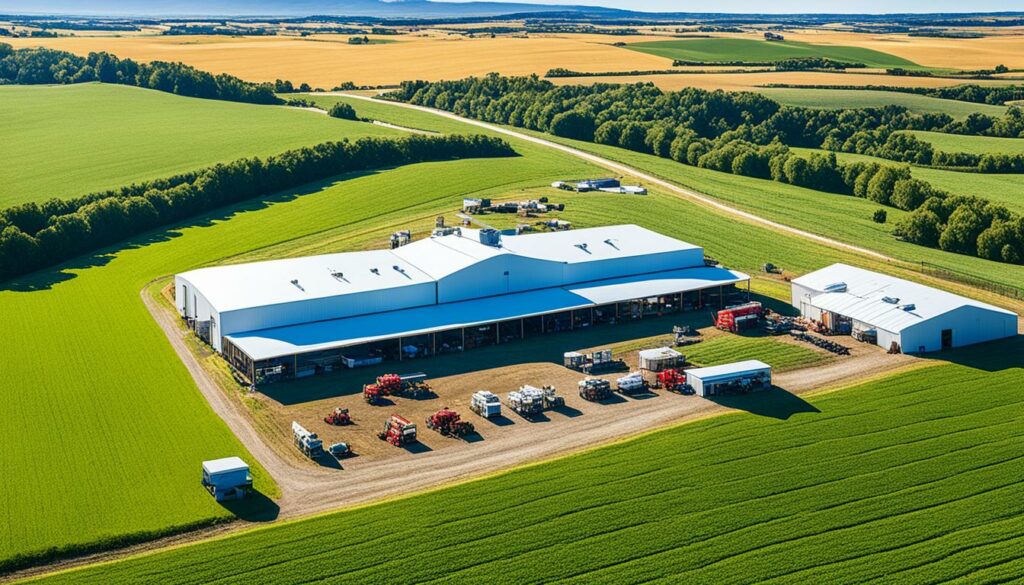
In 2018, the U.S. saw 146 people die because of tractor accidents. This shows why agricultural safety protocols are so important. They are not just rules, but they’re made to save lives on farms.
Agricultural safety protocols also help with risks from chemicals. Things like pesticides and fertilizers can be very dangerous. It’s vital to follow the safety rules when dealing with these chemicals. This protects workers from getting sick.
Besides chemicals, working with animals has its dangers. Livestock can bite, kick, or stampede. They can also spread diseases. Making sure everyone follows strict safety compliance rules helps lower these risks. This keeps people safe when they’re near animals.
Weather changes, like droughts and storms, make farm safety harder. By sticking to regulations, farms can prepare for these problems. This helps keep workers safe and farms running smoothly.
| Regulatory Body | Role in Safety | Impact on Agriculture |
|---|---|---|
| OSHA | Enforces workplace safety regulations | Prevents accidents and injuries |
| USDA | Ensures fair labour standards and environmental protection | Promotes ethical farming practices |
| Safe Work Australia | Collaborates with governments to enforce health and safety regulations | Enhances workplace safety in agricultural sectors |
Technology is changing farm safety too. Things like IoT and safety gear are making farms safer. They help watch over farms in real-time. This lowers the chance of accidents and makes following safety rules easier.
Having a solid plan for emergencies is crucial. It ensures that farm people and animals are safe. This is important when natural disasters or accidents happen. A good plan includes how to evacuate and where to shelter on the farm.
Evacuation plans need to be well thought out. They must cover different situations. This means making sure everyone and every animal can get out safely. Knowing the best routes, gate operations, and hazardous material locations is key. Plans should make sure there are clear routes and safe spots for everyone to go to.
Sometimes, staying on the farm is safer than leaving. Sheltering strategies are important in this case, especially in severe weather. Plans need to have ways to keep power and fuel available. They should say where to shelter and how to keep in touch with help.
An important step in farm emergency preparedness is keeping good farm maps. These maps should show roads, fences, and where animals are. Also, keep a list of the animals, crops, machinery, and any dangerous materials on the farm. This is vital for planning for emergencies.
| Farm Emergency Plan Elements | Details |
|---|---|
| Emergency Contacts | Include contacts like the vet, county emergency management, Extension office, insurance agent, and farm service providers. |
| Utility Shut-Offs | Know locations and procedures to quickly shut off utilities during emergencies. |
| Training | Provide training for medical emergencies, such as heart attacks, allergic reactions, injuries, and confined space incidents. |
| Backup Resources | Ensure availability of backup power and fuel resources for sheltering in place. |
| Evacuation Equipment | Have essential evacuation equipment like trailers, trucks, tractors, and fire extinguishers readily available. |
| Farm Map and Inventory List | Maintain comprehensive maps and lists detailing roads, buildings, livestock, machinery, and hazardous substances. |
Building detailed farm maps and farm inventory lists are keys in a strong farm safety plan. They help greatly in being ready for emergencies. You get all the info needed quickly about the farm’s layout, livestock, and important supplies.
The farm maps list field names, access roads, and all important places on the farm. They’re useful for showing where you can find buildings, equipment, and dangerous materials. It’s smart to give these maps to emergency teams so they can act fast in a crisis.
The farm inventory lists also play a big role in quick responses. They detail where safety items like pesticides and first aid kits are kept. By having these lists up-to-date and nearby, dealing with emergencies becomes smoother and faster.
They don’t just cover the safety stuff but also the daily care of animals. You’d find information like what animals eat and their care schedules in these lists. This ensures animals are taken care of even when things go wrong.
Add detailed contact info in the safety plan too. It must have the owner’s contact along with others like chemical sellers and emergency services. This contact list helps make sure the right help comes quickly by providing clear details about the problem.
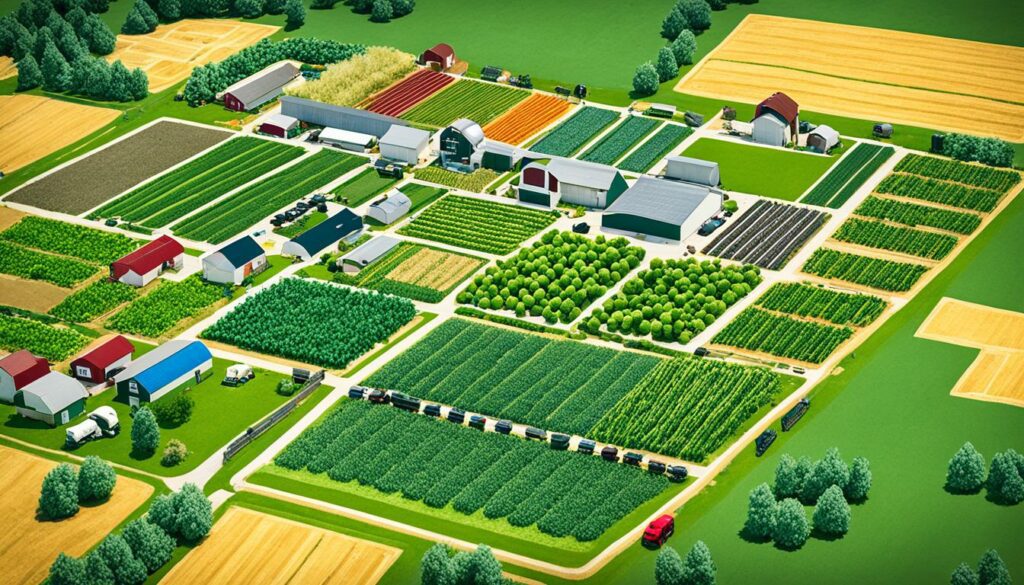
During emergencies, keeping tabs on where workers are is vital. Using a system that updates regularly with easy-to-understand messages improves safety. Information given to the media must be accurate and on time during crises as well.
Plus, being ready for how emergencies might affect the market is equally important. Having back-up plans for selling your goods is a must. Integrating these plans into the farm safety plan keeps the farm running, helping create a safer, stronger farming community.
| Key Elements | Details |
|---|---|
| Farm Maps | Fields, access roads, buildings, equipment, utilities, chemicals |
| Farm Inventory Lists | Pesticides, first aid kits, fire extinguishers, feed, veterinary supplies |
| Daily Animal Care | Feed amounts, feeding schedules, ventilation, manure management |
| Emergency Contact Information | Owner’s home number, chemical dealers, emergency personnel |
| Notification System | Tracking of workers’ locations during emergencies |
| Market Operations | Backup plans for market outlets during emergencies |
In the area of farm emergency preparedness, teaming up with local emergency services is key. This includes working closely with the police, fire brigade, and medical teams. Such partnerships make farms ready for emergencies and help everyone respond better when something goes wrong. Natural disasters have become more common in rural areas. These include flooding, hurricanes, and wildfires. This change highlights how crucial it is to work together for farm safety.
Natural disasters can harm crops, animals, and people’s health. For example, after a hurricane or flood, mold can quickly become dangerous. If you have asthma or a weak immune system, this is a big risk. That’s why farmers need to plan ahead with local emergency services. This planning makes sure everyone knows what to do when disaster strikes.
Working with emergency groups means farms are better prepared. They know how to evacuate safely and where to find shelter. This also helps with getting resources quickly, especially if there’s no power. It can stop accidents like carbon monoxide poisoning from using the wrong energy sources.
To be truly ready for emergencies, farmers must think about mental health, too. Local emergency services can help with plans and support for handling mental health after a disaster. Getting help for mental well-being makes the whole community recover better, both physically and emotionally.
Knowing about the local area, like where floods could happen, is important for safety. This local wisdom, when combined with the skills of emergency services, helps us deal with disasters better. It means we can act before disasters happen, staying ahead instead of just reacting.
Overall, linking up with local emergency services is really important for farm safety. It gets farmers and the wider community ready for emergencies. This makes sure rural areas can bounce back faster and smoother after the chaos of a natural disaster.
Using safety technology in farming is key for better safety. With new tech like IoT, farmers can watch over their farms better. This cuts down on risks and makes farms safer for people to work.
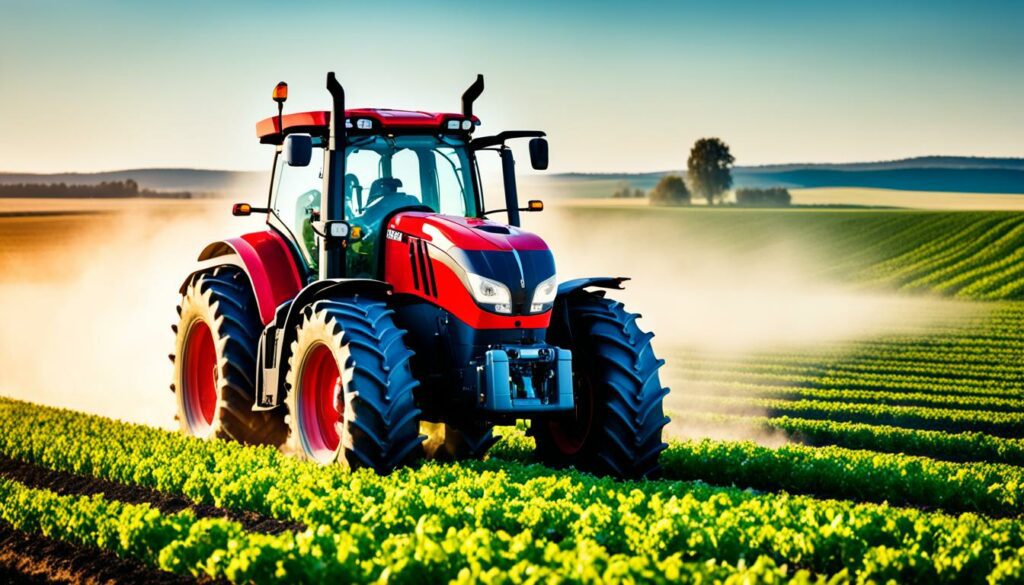
IoT devices are changing how we keep farms safe. They let farmers keep an eye on machines, the weather, and how the animals are doing in real time. This helps find dangers early, so there are fewer accidents. In the US, every day about 100 farm workers hurt themselves and can’t work. So, these gadgets are really important in keeping people safe.
Today, farm machines are made with safety in mind. They have features like stopping automatically, protecting from rollovers, and avoiding crashes. This is a big deal because the chance of dying at work in farming is high – 23.1 out of every 100,000 workers. By using these smart machines, farms can avoid many injuries and make farms safer overall.
Using new tech like this brings lots of benefits. It protects the 1.3 billion people working on farms around the globe. Plus, it makes farms run better and safer. This move towards high-tech safety is a big deal in making farms a place where people can work without risking their lives.
Seasonal safety planning is key for keeping farms safe. Each season brings its own risks to farm work. Take harvest time, for instance. The dangers of big machines like tractors are bigger. In 2018, the U.S. Bureau of Labor Statistics found 146 tractor-related deaths. This tells us how important it is to be extra careful and follow safety rules on farms.
Winter brings different risks we must be ready for. It’s crucial that buildings can handle harsh weather. With climate change, the risk of fires and storms increases. To help farms cope, the USDA offers help with improving safety and buildings.
We also must be careful with pesticides and fertilizers. They are very dangerous, so use them safely when needing to. Livestock can also be dangerous at times, causing bites or kicks. It’s essential to stay alert and check safety steps often.
Handling seasonal risks the right way makes a big difference. It can save lives and boost farm work. We should follow advice from safety groups like Safe Work Australia. They guide us to make our farms safer during all seasons.
A strong safety plan needs a detailed list of emergency contacts. This is key for farm safety. In places like Minnesota, farmers must have these lists. They help when disasters like tornadoes, floods, and fires happen. Making lists early helps farms stay strong during tough times.

The first step in getting ready for emergencies is making a list of who to call. You should write down who to contact for vet services, emergency help, and farm advice. These emergency contacts make sure quick and smart choices can be made, even if the usual person is not there.
It’s also vital to list all the farm’s living things, tools, toxic stuff, and dangers. This is for being quick and smart in an emergency. It also helps emergency teams know what’s on your farm. Checking gas spaces for toxic air is a key part of keeping the farm safe.
There is a detailed table below. It shows what’s important to manage farms in hard times:
| Key Management Areas | Details |
|---|---|
| Emergency Contacts | Vets, local officials, insurance, and supply chain contacts |
| Daily Animal Care | What to feed, how often to care, keeping air fresh, cleaning waste, and dealing with sick animals |
| Labour Management | Skills training, special animal healthcare, and keeping diseases outside |
| Obtaining Resources | Getting medicine, emergency tools, food, and learning how to use equipment |
| Market Operations | Dangers like losing places to sell because of disasters or market issues |
For dangerous events like grain traps, having the right gear is vital. This includes safety harnesses. A good emergency list and knowing how to care for animals, manage work, find resources, and handle market issues are key on farms. Sharing this information with all farm workers makes everyone safer and stronger.
It’s important to regularly check and update safety plans on the farm. This helps keep everyone safe. Safety measures must keep up with how the farm works and any new risks.
Regular checks and updates can make farms much safer. They lower the chance of accidents, caring for farm workers and visitors.
Checking how well current safety plans work is vital. Audits and reviews show what’s good and what needs to be better. They help make smarter choices for a safer farm.
Citing the Food Safety Modernization Act, executive director Marcel Hacault of the Canadian Agricultural Safety Association highlights, “Farm operators should review and update their safety plans regularly to ensure they remain effective and meet new standards.”
Farms are always changing, needing safety plans to adapt too. Whether it’s new laws, new tools, or different seasons, the farm’s safety must change too. This way, it stays safe for everyone.
Keeping safety measures updated is key. It keeps up with new risks and helps keep the farm a safe place. This also makes sure the farm meets safety laws and protects people and things.
Regularly updated safety plans are essential. They include new training and safety steps. Also important are training certificates and emergency lists. As well as water checks and other records, making safety plans complete and effective.
Creating a strong safety culture on the farm is key to reducing risks. Each year, a third of farm workers face injuries. This shows why it’s so important to have good safety rules on the farm. Almost 80% of farm accidents are due to being careless or not managing dangers safely. This means we can prevent many accidents by being more careful.
Several things are crucial for making sure the farm is safe. Leaders must be fully behind safety. They should encourage and reward safe actions. Also, everyone should share the belief that safety comes first. Constantly getting feedback and making changes is what makes farm safety work.
Hiring and training are also important for farm safety. New and current workers must know the right ways to use equipment, handle chemicals, and deal with emergencies. Leaders need to show they take safety seriously. This helps everyone make safe choices daily.
Being ready for natural disasters is critical too. A clear plan that’s shared and practiced helps a lot if something unexpected happens. Every farm does better when safety is a top concern. This reduces accidents and makes the whole team stronger.
To wrap up, farm safety needs everyone’s ongoing effort and a good plan. Safety rules should cover everything from regular work to crises. Doing so keeps everyone safe and healthy on the farm.
It’s key to have a detailed farm safety plan to keep workers safe and the farming industry strong. Following the health and safety rules in Nova Scotia’s Occupational Health and Safety Act is a must. This applies to every work site and sets out what’s needed for safety, depending on how many people work there. For farms with 5-19 staff, having their own safety person is essential.
Such plans help cut down on the big money losses from farm accidents. It’s also vital to have the right insurances, like workers’ compensation. This insurance helps both the employer and employees after on-the-job accidents. It protects bosses from being sued and gets workers back on their feet quickly. Plus, there are special insurances for owners, partners, and family in the business.
Adding safety steps like checking equipment often and wearing the right gear can lower accident risks. In the US, about 170,000 farm injuries happen each year. This shows why having a safety plan is so important. In Nova Scotia, the Workplace Health and Safety Community is there to help. They offer support and advice for making effective safety plans. A strong safety plan not only meets rules but also shows care for people and the environment.
A farm safety plan helps keep everyone safe on the farm. It looks at risks and makes sure work areas are safe. This includes things like checking for dangers, knowing what to do in emergencies, and how to use equipment and chemicals safely.
Farm safety is key because it keeps people, animals, plants, and the environment safe. It cuts down on accidents and means the farm can keep running well without harm to anyone or anything.
There are many risks on a farm. These include getting hurt by machines, coming into contact with hazardous chemicals, dealing with large animals, and facing extreme weather. Knowing about these dangers helps keep people safe.
Making sure PPE is used right means picking the correct gear, teaching workers how to wear it, and making sure it’s in good condition. Following guidelines on PPE reduces the chances of getting hurt.
Training should focus on staying safe around equipment, handling chemicals carefully, and treating animals the right way. Keeping this training up to date means that everyone knows how to avoid danger.
It’s important to regularly check the farm for new risks and find ways to deal with them. Doing this often keeps the farm a safe place to work by preventing accidents.
A good farm safety plan has steps for handling risks, plans for emergencies, rules for staying safe, and training staff. Making this plan work needs everyone on the farm to get involved and follow the safety rules.
To follow safety rules, know the laws set by groups like OSHA and HSE. Doing this makes farming safer and shows you care about doing things right.
An emergency plan should say how to get to safety, where to go for shelter, and how to work with emergency services. This plan makes sure the farm is ready for any kind of emergency to protect people and animals.
Having detailed maps and lists helps in emergencies. They show where everything is, helping to quickly respond to dangers and keep farm work going when things are tough.
Working with the police and fire services helps with quick help in an emergency. It makes a big difference when everyone knows what to do and helps each other during a crisis.
New tech like IoT and smart machinery makes safety more efficient. These tools watch over the farm, cut down on mistakes, and make it safer for everyone working there.
Seasons can bring different kinds of danger, like more work with machinery during harvest or making sure buildings are safe in winter. Planning for these risks is crucial to staying safe all year round.
A list for emergencies should have phone numbers of important people and services, such as vet clinics, the police, your insurance, and your suppliers. This list helps get help fast when it’s needed most.
Farm safety plans must be checked and improved regularly to stay effective. With the right changes, the farm can keep being a safe place as things change and grow.
To make the farm safe, everyone needs to care about safety. This means leaders show the way, people talk openly about dangers, and we celebrate those who always work safely. It makes sure everyone is looking out for one another.